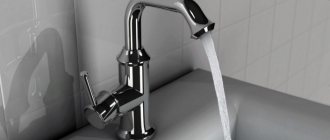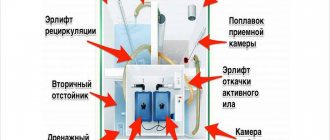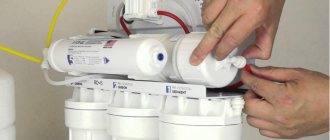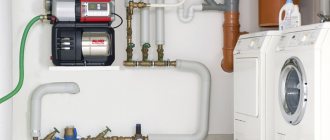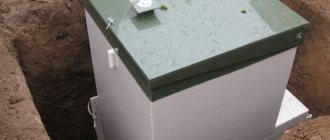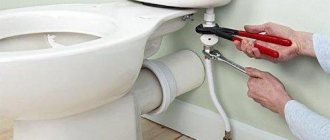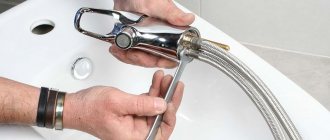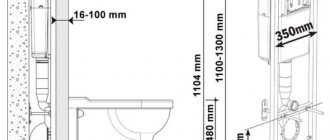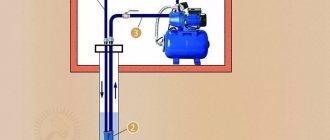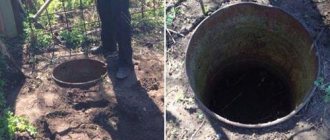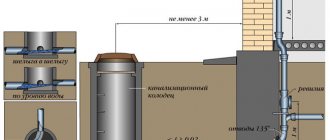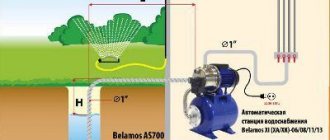Ball valves are modern products that replaced conventional rod valves, at the bottom of which a thick rubber band was screwed, designed to stop the water. The stem of such a tap pressed against the rubber, as a result of which the water stopped flowing. Modern ball valves are more convenient and attractive in appearance; they have only one drawback: if the water contains a large amount of various salts, the ball-sphere quickly becomes slagged and the product stops working.
When installing a ball valve on the thread, it is necessary to wind fum tape, flax or liquid fum.
To prevent this from happening, you need to open and close the tap at least once every 2 months to remove salt deposits. Installing a ball valve is a fairly simple task and can be done with your own hands. However, in order to correctly and efficiently install a ball valve, you need to prepare for its installation and strictly follow the instructions.
Design features
Today, ball valves are the most widely used. It should be noted that the most common connection method is the coupling method, but the connection can also be made by welding. Similar models have the following design:
- The valve body acts as the main element. The fact that the connection is made using welding technology determines the use of special steel that can withstand high temperatures. The body is characterized by the absence of various protrusions, thereby eliminating the possibility of dirt accumulation.
- The ball is used as the main locking element. Stainless steel is used in its manufacture; in the central part there is a hole with different patency.
- Control is carried out using the handle. It has a shape that makes it easy to operate the device.
- The spindle is used to directly connect the handle to the ball. The shape of such an element is quite complex, which allows the installation of several compaction wheels. It is worth considering that the spindle is installed from the inside, which ensures a high degree of reliability when operating the device under pressure.
- Inside the faucet there is a ball seat, which is made of Teflon. This material is characterized by high resistance to mechanical stress.
- The locking pin limits the rotation of the handle.
We will pay special attention to the fact that the inlet and outlet pipes are represented by tubes made of metal, which can be easily welded. There are no threads or other elements on the surface, which complicate the welding process
What to look for when purchasing
Before installing a ball valve, you must take into account a number of indicators that will indicate its quality. This includes weight (if it is suspiciously light, then it makes sense to think about it), labeling (must meet all standards and requirements). Do not forget to read the passport, where it will be written in detail about what materials the product is made of.
|
Ball valve installation
In this article I will tell you how to correctly install a ball valve on water supply and heating pipes, but first I will tell you a little about the pros and cons of ball valves. At the moment, such valves are the most common, popular, and very practical and convenient; their undoubted advantage over old-style faucets is that there is no need to change the gaskets, since they have a different device and operating principle. There is a ball inside the faucet, in one position it is open, and when turned 90 degrees, the water is shut off, but there are also big disadvantages to ball valves: If the water is bad, the ball can become clogged, and if you do not turn it for a year, especially on hot water, then close it it becomes very difficult, and sometimes impossible, so you need to turn it at least once every 2 months to remove salt deposits.
If rusty water comes from the tap, then when opening and closing, scale or sand can damage the surface of the ball, and then the tap will etch in the closed position. On ball valves of average quality, with frequent opening and closing (most often found on hot water and heating), a leak begins from under the seal, of course it can be tightened, but in many cases the nut that tightens the seal rotates along with the lever and continues to drip, and Some taps do not have a seal at all, and if there is a leak, you can only throw it away and install a new one. And one more minus, you cannot install a ball valve in a room where the temperature may be less than 0 degrees in winter; when the water freezes, it breaks.
How to install a ball valve on a pipe
When installing a ball valve on a pipe, you must:
1. If you are replacing a faucet, you need to remove the old one, clean the threads of flax, and try screwing on the faucet. More than once I have encountered the problem that when removing an old valve, 2-3 turns rot, in which case it is necessary to trim the threads. The tap must be screwed onto the pipe with at least 4 turns!
2. If, when dismantling the old tap, the threads remained in normal condition, but when installing the tap, the tap is screwed on less than 4 turns, be sure to drive the threads with a die!
3. Check that the tap is screwed on 4-5 turns without flax, wind the flax. and tighten it 4-5 turns.
4. If you are installing plumbing or heating, then first accurately measure where the ball valve will be installed, cut it in the right place, cut the thread on the pipe, and screw it 4-5 turns.
And as usual, a few tips, if you have a centralized heating supply, and there is high pressure in the system, use ball valves from Bugatti, they have proven themselves very well, do not install valves that do not have an oil seal, if it starts to leak, you will not be able to fix it before replacing the faucet.
Ball valves come with internal threads on both sides, internal - external, external - external, and internal on one side, and on the other American, so calculate and buy those that are needed for further connection of the water supply or heating.
Watch the video, installation, installation of a ball valve, and how to cut a thread on a pipe.
Features and applications of ball valves
Ball coupling valves are most often used for equipment of gas, water supply and heating systems of residential buildings and public buildings. For example, installation of taps on radiators is recommended using coupling taps.
Such cranes have the following advantages:
- they are practical;
- easy to use;
- have small dimensions;
- They are easy to install and dismantle without the use of special equipment.
It is advisable to use a coupling ball valve for installation on pipes with a diametrical cross-section that does not exceed 40-45 mm. For larger pipes, it is better to install flanged ball valves.
Features of the resulting compound
Despite the fairly widespread use of coupling and flange connection methods, some ball valves are connected using welding. This connection method can be characterized as follows:
- It is possible to connect a ball valve even to a pipe that does not have a thread or a flange cannot be attached.
- The resulting seam is characterized by high reliability. If the welding technology is followed, the connection will be able to withstand high loads.
- After installation work has been completed, it will not be possible to dismantle the locking element for maintenance or replacement. An exception is the case when metal is being cut.
- If the welding technology is violated, the resulting weld will be of low quality, and with prolonged use it may develop a leak.
- Welds are characterized by relatively low resistance to hydraulic shock.
As practice shows, a welded joint can withstand a fairly high load and last for a long period. That is why today you can often find a situation in industry where a ball valve is connected precisely when using such technology.
Common mistakes
When working with any fastenings, you must follow the rules, otherwise mistakes may occur that will not lead to the best consequences. This includes:
- The most common mistake is initially choosing the wrong ball valve. It is necessary to take into account pressure and other factors that may affect operation. Before installation and purchase, it is recommended to read the instructions for the product.
- Violation of installation rules (for example, skewed flanges, which we mentioned earlier) can lead to the fact that the crane will not cope with its task.
Remember that installing a ball valve is not a difficult task, but only if you follow all the tips in the instructions.
|
Gas valve installation
Preparatory stage
To change the gas valve in the kitchen yourself, you need to prepare:
- new tap;
- two gas keys. One wrench is required to unscrew the threads, and the second to hold the down tube stationary. Otherwise, the pipeline leading directly to the gas stove may be damaged;
- means for sealing threaded connections. FUM tape, Tangit Unilok thread or regular linen thread are suitable. When using linen thread, additional treatment of the sealing material with paint is necessary;
Special thread for sealing threaded connections
graphite lubricant intended for gas valves;
Special composition for gas appliances
pipe plug. If you replace the valve together, you can do without using a plug.
Replacement process
The gas valve is replaced according to the following scheme:
- the gas supply to the living space is cut off. To do this, the gas valve handle is turned to a position perpendicular to the pipe;
Gas valve in closed position
- the valve is unscrewed from the pipe. If you cannot unscrew the thread, it is recommended to treat the threaded connection with WD-40, which will ensure smooth operation. If a welded valve is installed in the apartment, then it is cut off using a grinder, and threads are cut on the pipes;
- A temporary plug is installed in place of the valve. If the work of replacing the gas valve is carried out by two people, then instead of the plug you can use your partner’s finger. This procedure will facilitate the process of installing a new faucet;
- a sealing thread is screwed onto the thread;
Winding flax thread to make the threaded connection tight
- a layer of graphite lubricant is applied on top of the thread;
Final preparation of threads for valve installation
- A new faucet is being installed.
When working indoors, it is recommended to open windows and turn off all electrical appliances. These actions will lead to maximum safety.
The process of replacing a gas valve yourself is presented in the video.
Leak test
After installing the gas valve, it is recommended to check the tightness of the device and the resulting connections. For this:
- open the tap and start supplying gas to the stove;
- prepare a saturated soap solution, which is applied to the tap and connection points.
Finding gas leaks using a soap solution
If the device and threads allow gas to pass through, small soap bubbles will form at the leakage site. If a leak is detected, the problem must be corrected quickly.
Doing the job of replacing a gas valve yourself is risky.
Any careless action or violation of safety regulations may result in an explosion. Therefore, it is recommended that replacement be carried out by qualified personnel.
Recommended bolts and studs for mounting ball valves
| DN, mm | Bolt dimensions (GOST 7798-70) | Stud sizes (GOST 22042-76) | ||||||
| PN, MPa | Qty | PN, MPa | Qty | PN, MPa | Qty | PN, MPa | Qty | |
| 1,0 | 1,6 | 2,5 | 4,0 | |||||
| 15 | M12x45 | 8 | M12x45 | 8 | M12x55 | 8 | M12x70 | 8 |
| 20 | M12x50 | 8 | M12x55 | 8 | M12x55 | 8 | M12x70 | 8 |
| 25 | M12x50 | 8 | M12x55 | 8 | M12x55 | 8 | M12x70 | 8 |
| 32 | M16x55 | 8 | M16x70 | 8 | M16x70 | 8 | M16x100 | 8 |
| 40 | M16x70 | 8 | M16x70 | 8 | M16x70 | 8 | M16x100 | 8 |
| 50 | M16x70 | 8 | M16x80 | 8 | M16x80 | 8 | M16x100 | 8 |
| 65 | M16x70 | 8 | M16x80 | 8 | M16x80 | 16 | M16x100 | 16 |
| 80 | M16x70 | 16 | M16x80 | 16 | M16x80 | 16 | M16x100 | 16 |
| 100 | M16x70 | 16 | M16x80 | 16 | M20x90 | 16 | M20x120 | 16 |
| 125 | M16x80 | 16 | M16x80 | 16 | M24x100 | 16 | M24x130 | 16 |
| 150 | M20x90 | 16 | M20x90 | 16 | M24x100 | 16 | M24x130 | 16 |
| 200 | M20x90 | 16 | M20x100 | 24 | M24x100 | 24 | M27x160 | 24 |
Each bolt unit is equipped with a GOST 6402-70 washer - 1 piece, and a GOST 11371-78 washer - 1 piece. and Nut GOST ISO 4032-2014 - 1 pc. Each unit of the stud is equipped with a GOST 6402-70 washer - 2 pcs., GOST 11371-78 washer - 2 pcs. and Nut GOST ISO 4032-2014 - 2 pcs. Ball valves are equipped with flanges in accordance with GOST 33259-2015 (type 01 or type 11, version B, row 1). Ball valves series VD for a pressure of 4 MPa are equipped with flanges only in accordance with GOST 33259-2015 (type 11, version B, row 1)
- Before installing the tap, the pipeline must be cleared of dirt, sand, scale, etc.
- Before proceeding with installation, make sure that the crane will not be subject to load from the pipeline, the connecting ends of the pipeline are connected without distortions, and the pipeline has the necessary supports.
Opening and closing valves
You can determine whether a valve is open or closed by several criteria, depending on the type of device installed.
Determining Ball Valve Position
To determine the state of the ball valve, you can use:
- control handle;
- recess located on the rod.
The ball valve can be equipped with two types of handles:
- a handle, which is an oblong element attached to the body of the device;
- a butterfly handle, consisting of two similar parts, located symmetrically relative to the attachment point.
The valve closes if the handle is turned perpendicular to the device and the direction of the pipeline, and opens if the handle is turned in the direction of the axis of the device and, accordingly, the pipeline.
Determining the valve status by the handle installed on the device
The following video will help you determine the condition of the valve by looking at the handle.
If the handles are broken or completely missing for some reason, is it possible to find out the position of the valve? To determine the condition of the device under the circumstances under consideration, you can use the groove located on the rod.
Element by which the valve position can be determined
If the recess is located parallel to the pipeline, then the valve is open and allows liquid (gas) to pass through. If the recess is located perpendicular to the direction of the pipes, then the valve is closed and the movement of liquid through the system is impossible.
Determining valve position by groove
For ease of use of the ball valve, there are special protrusions on the body of the device, which are designed to limit the rotation of the handle and, as a result, extend the period of use of the device.
Determining the position of the plug valve
Which direction should you unscrew the plug valve if there is no handle on the device, and how can you find out the position of the valve in this case?
To determine the position of a valve that does not have a handle, you must:
- find the slot (risk) on the top of the rod;
- visually check the status of the device.
Determining the state of a plug valve without a handle
To close any type of valve, you must rotate the control handle or mounting rod in a clockwise direction. To open the valve, the handle rotates in the opposite direction, that is, counterclockwise.
Connecting dimensions and recommendations for installation of ball valves
Ball valves of the VD series produced by JSC "ARMATEK" are flanged.
The connecting dimensions of the valves correspond to GOST 33259-2015 (type 01 or type 11, version B, row 1).
The choice of flanges occurs in accordance with the pressure of the working medium. Ball valves PN 1.6 MPa are equipped with flanges for PN 1.6 MPa, ball valves PN 4.0 MPa are equipped with flanges for PN 4.0 MPa.
For the correct and convenient selection of fastener kits, we recommend using the data in the table.
To install ball valves, it is necessary to use threaded bolts and studs GOST 22042-76, GOST 7798-70.
Instructions for welding work
The installation of ball valves in a production line must be carried out exclusively taking into account the requirements of the project, as well as common standards. The main recommendations are the following:
At the time of work, it is strictly forbidden to secure the device by the handle or other technological elements. This is due to the fact that the applied load can lead to very serious consequences. Even slight deformation of the rod causes a decrease in the tightness of the entire device.
Welding work can only be carried out in the open position of the device. At the same time, you need to make sure that there are no various contaminants inside that could get inside during transportation.
It is recommended to remove the handle while welding. Often, in its manufacture, a material is used that can be damaged by drops of hot material.
When installed in a vertical position, the top seam is welded in a fully open position. The bottom seam is obtained in a completely closed position, which eliminates the possibility of a backdraft effect of warm air.
For diameters ranging from 10 to 125 millimeters, it is recommended to use electric welding; for larger diameters, this condition is mandatory.
The bevel of the pipe must be ideal for the shut-off element
That is why, in case of poor surface quality, the end is cut off and carefully prepared.
When welding directly, care must be taken to ensure that the valve body does not heat up. This is due to the fact that too high a temperature can lead to very disastrous consequences.
Heating the body to a temperature of 100 degrees Celsius in the area of the seat is considered overheating. It is worth considering that in most cases a special coolant and a dampened cloth are used. Welding can be carried out in several stages to reduce the likelihood of surface overheating. An increase in plasticity causes surface deformation and loss of tightness of the entire structure.
After receiving the seam, it is prohibited to open and close the reinforcement for a long period. This can only be done after the surface has completely cooled. Otherwise, the internal components may be damaged.
The construction length of the pipes should not be shortened. This is due to the fact that it is selected taking into account the likelihood of heating the main structure.
After completion of the work, the quality of the seam is checked in accordance with established requirements. To protect the surface, a paint coating is applied. The final stage is flushing the tap to remove any debris that may have gotten inside the structure during welding.
With welded couplings
The third method is a combination of the previous two: couplings are used, which on one side are welded to a polypropylene pipe, and on the other side have a thread for screwing in the tap.
- This approach eliminates the risk of leaks and at the same time makes the structure collapsible, so that the tap can be easily replaced.
- Its implementation still requires a welding machine and polypropylene welding skills.
The method is selected based on the characteristics of a particular water supply system. For some cases, one method is relevant, for others, another. The main thing is to choose high-quality taps and connecting elements: the durability of the final structure depends on their reliability. is ready to offer its polypropylene products for installation in water supply systems.
Selection of gas valves
If a malfunction is detected in the operation of the gas valve, it is recommended to replace the device as soon as possible. First of all, you need to select a new valve. When choosing, experts recommend considering:
- type of valve;
- basic device parameters.
Kinds
The gas pipe valve can be:
cork. The body of the plug valve contains a conical element driven by a flywheel. There is a hole in the conical element (plug), which, when combined with a hole in the pipe, allows gas to flow to the equipment. The seal acts as a sealing material that seals the connection between the faucet and the pipes;
Sectional view of a cork valve
spherical The design of a ball-type gas valve differs from a plug valve in that the locking mechanism is based on a ball made of durable metal. The ball has a hole, which, when the flywheel is turned, is located along the gas pipeline and in this way passes gas to the consumer.
Gas pipeline valve with ball locking mechanism
Experts recommend using ball valves for domestic gas pipelines, as they are more reliable.
According to the method of connection to pipes, a household ball valve can be:
threaded The valve is connected to the gas pipeline pipes with a threaded connection;
Valve installed with threaded connection
flanged. The connection to the pipes is made using flanges, which in turn are fixed with bolts;
Gas valve fixed with flanges
welded, that is, installed using a welding machine.
Gas valve installed by welding
Threaded and flanged valves are reusable, that is, if necessary, you can remove the device from the gas pipe, check its functionality, carry out repairs and install it in its original place. The welded valve can only be installed once.
Basic selection parameters
To select a gas shut-off valve, it is recommended to pay attention to the following factors:
- pipeline diameter. The shut-off element of the valve must completely block the pipe in the apartment. If the valve is larger or smaller, the tightness of the tap will not be complete;
- pitch and diameter of the thread on the pipeline. To quickly replace the device, it is necessary that the specified parameters completely match. Otherwise, you will need to purchase and install additional adapters;
- the material from which the gas pipeline valve is made. It is more advisable to purchase brass taps, as they have a longer service life. You can also find silumin, zinc and plastic taps on sale. You can distinguish the material used to make the valve by weight. Brass faucets are heavier than faucets made from other materials. In addition, you can inspect the place where the thread is cut. Brass has a yellow tint, and all other materials (except plastic) are gray;
Gas valve made of nickel plated brass
- The valve body must be free of chips, sagging, cracks and other defects. The presence of these factors indicates non-compliance with the rules for manufacturing the product, which will lead to a reduction in service life;
- It is more advisable to purchase valves from well-known manufacturers. For example, you can choose cranes manufactured by Bugatti (Italy), Dungs (Germany), Broen Ballomax (Poland).
Following simple rules when choosing a gas valve will allow you to choose a reliable device with a long service life.
Principle of operation
Photo - with an electric drive.
A ball valve is a shut-off valve where the valve is a metal or rubber ball. It is connected to a lever or a special device that controls its position (gearbox, pneumatic or electric drive). The ball has a hole that must match the diameter of the connected pipe. When you turn and open the device, these holes coincide and water begins to flow. If you turn the lever in the other direction, the flow stops.
In apartments, houses and utility rooms, a lever mechanism is used, but to control the operation of the device on large diameter bends, the use of drives is necessary. The main advantage of this mechanism is that you can control hot and cold water with one handle.
Sometimes ball valves are even installed in the heater of a VAZ car to control antifreeze fluid. But this is not the best solution - dust and dirt gets clogged under the ball, which significantly reduces its service life.
Photo - faucet on the stove
Types of ball valves:
- Flanged. Mounted on large diameter communications. A distinctive feature is the presence of an additional sealing element near the locking ball, which provides the maximum level of sealing. Therefore, they can be used for pumping gas and oil products, heaters and installed on heat converters;
Photo - flanged - Fittings. The most common. They can be dismantled many times; the locking mechanism can be either static or smooth;
Photo - design of the fitting model - Welded. Installed only once, used in main water pipelines, in conditions of high pressure and if a well-free installation is needed.
Based on the material of the housing, there are polyethylene and metal (copper, stainless steel, steel). The former are necessary in special operating conditions, for example, where the pressure exceeds 10 bar.
Photo - rubber lock
Why is the brass ball valve so widespread?
Shut-off valves have long become a necessary element when planning heating and plumbing systems in the residential sector. The most popular among all types of shut-off valves is the brass ball valve. It is used in different sections of the highway.
The popularity of ball valves arose due to the following advantages:
- long service life (no need for constant maintenance);
- exceptional tightness (due to the solid structure of the body);
- pleasant general appearance of the taps;
- ease of installation (you just need to thread the inlet and outlet sections of the pipe).
There are also warnings that stipulate those cases in which the installation of brass ball valves is undesirable. We are talking about highways with a large number of foreign impurities in the transported substance. In normal operation, the ball mechanism fits quite tightly to the fluoroplastic linings of the body. But constant exposure to an environment with various impurities can cause a leak in the faucet.
According to the production method, brass ball valves can be of two types: cast in molds or forged (using a mechanical press). Forged products, unlike cast ones, are characterized by greater strength and reliability. There is a simple explanation for this: during forging, air cavities do not appear in the metal structure, which are characteristic of casting production.
Since ball valves are, as a rule, made not from pure brass, but from alloys with different electrochemical potentials, to prevent corrosion it is coated with a special protective layer using the galvanic application method.
It is also not recommended to use brass ball valves in pipelines with a temperature of the transported substance above +150 °C. Overheating can cause microcavities to appear in the faucet body, increasing its fragility.
Read material on the topic: Ball valves for water supply
